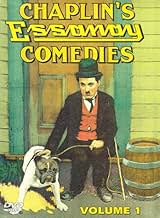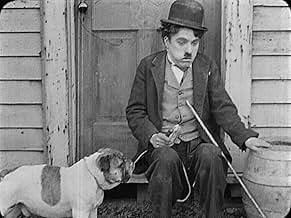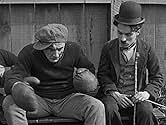The Champion
- 1915
- 31min
Agrega una trama en tu idiomaWalking along with his bulldog, Charlie finds a "good luck" horseshoe just as he passes a training camp advertising for a boxing partner "who can take a beating." After watching others lose,... Leer todoWalking along with his bulldog, Charlie finds a "good luck" horseshoe just as he passes a training camp advertising for a boxing partner "who can take a beating." After watching others lose, Charlie puts the horseshoe in his glove and wins. The trainer prepares Charlie to fight t... Leer todoWalking along with his bulldog, Charlie finds a "good luck" horseshoe just as he passes a training camp advertising for a boxing partner "who can take a beating." After watching others lose, Charlie puts the horseshoe in his glove and wins. The trainer prepares Charlie to fight the world champion. A gambler wants Charlie to throw the fight. He and the trainer's daught... Leer todo
- Dirección
- Guionista
- Elenco
- Bob Uppercut - Champion
- (sin créditos)
- Enthusiastic Fan
- (sin créditos)
- Sparring Partner
- (sin créditos)
- Second Sparring Partner
- (sin créditos)
- …
- First Sparring Partner
- (sin créditos)
- …
- Second Stretcher Bearer
- (sin créditos)
- Bit Role
- (sin créditos)
- Bit Role
- (sin créditos)
- Second Cop
- (sin créditos)
- Sparring Partner
- (sin créditos)
- Trainer's Daughter
- (sin créditos)
- Bit Role
- (sin créditos)
- Sparring Partner
- (sin créditos)
- Ringside Vendor
- (sin créditos)
- Spike Dugan
- (sin créditos)
- Crooked Gambler
- (sin créditos)
- Dirección
- Guionista
- Todo el elenco y el equipo
- Producción, taquilla y más en IMDbPro
Opiniones destacadas
I like quite a lot of the slapstick. Of course, there is nothing funnier than his boxing sequence in 'City Lights' (1931). Here he's trying out several things. When he's boxing fodder, he puts a horseshoe into his glove. Then during the long boxing match, he's doing a lot of what would recognizable to most people who's seen the boxing match in 'City Lights'.
A lot of times when I watch these early comedies from Chaplin, I get the feeling that he is often trying to create at least a mildly engaging story throughout which he can throw in a lot of kicking and punching scenes, but in this movie it's the kicking and punching the drives the plot, giving the film an unusually honest feel.
High-energy physical slap-stick is what Chaplin did best at that time, and smacking around a huge mountain of a man while he dances carelessly around as only he can is certainly a treat to watch. And the climactic battle between Charlie and the meaty Bob Uppercut (or Young Hippo, depending on which cannibalized version you may see) is well-acted and fun.
Mack Sennett like his comedies to be fast paced and high energy, without too much time wasted on things like characterization or even story. But in The Champion, Chaplin proves that we can have well-developed characters, an easily discernible story, and still have enough action and solid slap-stick to keep the shorter attention spanned audience members entertained. This is definitely one of the best short comedies that Chaplin had made up to that point.
The set-up of an up-and-coming boxer who fights his way to the top, is then bribed into throwing a fight and has to choose between his integrity and the payoff was an established cliché even back then. This well-known sequence of events allows Chaplin to mess around with stereotypes or subvert conventions. For a start, there is the fact that Charlie is a scrawny little feller, who essentially cheats his way to the championship. Then there's the farcical training routine, which Chaplin cross-cuts with the opponents more serious routine to give it more comedy impact, followed by the tramp's nonchalant seeing-off of Leo White's over-the-top sinister villain.
Throughout Chaplin is showing more confidence in his staging and arrangements. He allows himself to become a more marginal figure in some sequences – for example when Spike Duggan is knocking out one challenger after another, Charlie isn't doing very much, and is off-screen half the time, but it's his reactions to the growing number of defeated men that is funny. The other characters simply act naturally, whereas Chaplin is the originator of all the comedy.
In Chaplin's previous picture, A Night Out, he came dangerously close to becoming a double-act with Essanay's resident comic Ben Turpin. A large part of Chaplin's humour was based on reacting to other comedy characters, so he needed to have his supporting cast of burly bullies and pompous twerps to antagonise. However in the Champion you can see he is being careful not to let any of them have too much screen time. Although Bud Jamison, Leo White and Ernest van Pelt all do a great job, each of them is a walk-on, walk-off character; none of them shares the picture with Charlie. Ben Turpin has a tiny part as a vendor, but even in this one-shot role he manages to violate Chaplin's rule of the tramp being at the comedic centre of attention, stealing the laughs as he scrambles over the crowd to reach a customer. This would be Turpin's last picture with Chaplin.
And now, we finish with the all-important statistic – Number of kicks up the arse: 1 (1 for, 0 against)
¿Sabías que…?
- TriviaThe film was restored in 2014 through the Chaplin Essanay Project thanks to the financial support of the Niles Essanay Silent Film Museum.
- ConexionesEdited into Chase Me Charlie (1918)
Selecciones populares
Detalles
- Fecha de lanzamiento
- País de origen
- Sitios oficiales
- Idiomas
- También se conoce como
- Charlie the Champion
- Locaciones de filmación
- Productora
- Ver más créditos de la compañía en IMDbPro
- Tiempo de ejecución31 minutos
- Color
- Mezcla de sonido
- Relación de aspecto
- 1.33 : 1
Contribuir a esta página


































